Following the previous night’s New Year’s ‘festivities’, we got up fairly early, had breakfast, checked out and hit the road around 9:30 a.m. for our 750 km drive south. Unsurprisingly, the roads at this time on New Year’s morning were pretty much deserted.
Santa Cruz is about 40 km west of Chile’s main north-south road 5 which is part of the Pan American highway. Rather than taking the shortest route back to this road, we allowed our GPS to direct us along some country lanes to join the main motorway further to the south. We drove past many more fields of grape vines, but also corn and other crops. I imagine that these crops were Chile’s main produce before Chile’s wine industry really started growing 20-30 years ago.
About an hour later, and only one small error in our GPS’s directions, we were on the main highway heading south at 120 km/h but still with a good 7 hours drive in front of us and no hotel reservation at our intended destination. We had read that this road was good, but I was sceptical, to say the least having got used to Brazilian roads. However, the descriptions were right, the road was excellent and easily up to european standards. From Santiago to Puerto Varas/Puerto Montt it is at least 2 lanes in each direction. The only ‘problem’ were the tolls. There is a toll booth about every 80-100 km and the cost for the whole one-way trip (Santiago to Puerto Varas) was something in excess of 20,000 Chilean Pesos (£25/US$40). Apart from comfort/petrol/gas/food stops, we only stopped once to see an attraction described as a ‘small Niagra Falls’ in our guide book.
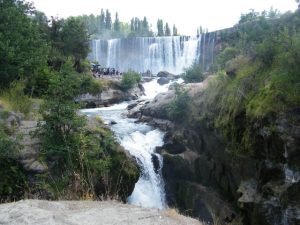
Salta del Laja is a waterfall about half way between Santiago and our southernmost destination of Puerto Varas. We had read about it a little before travelling and had been considering it as a possible overnight stop on the way back. However, we decided to stop on our way south. It was a good decision as the town is very small and extremely touristy. Despite this, the falls were quite impressive but nowhere near on the scale of Foz de Iguacu or even Niagra. For anyone taking a similar journey as us, I would suggest stopping, but only for a short break to stretch the legs etc. It is only a very short diversion from the main road and even used to be visible from the old road before construction of the motorway.
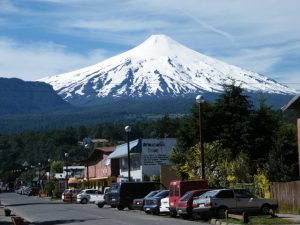
After our stop, we drove straight to Pucon eager to find accommodation. We arrived at Pucon early evening and set about finding a hotel. The first place we enquired was fully booked so we started to get concerned. However, we walked around the main square and found the Hotel Huincahue which had a room. It was quite a nice place with the exception of breakfast which was put out (covered) the night before!
Pucon is a town on the edge of a mountain lake and in the shadow of Villarrica volcano. It is in a really beautiful location with some stunning scenery around. It is reportedly one of Chile’s main holiday destinations. Perhaps consequently, Pucon has a good range of restaurants. We chose an Italian, but found it disappointing. This was not unusual in Chile.
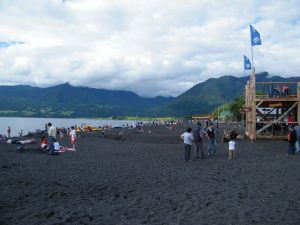
Apart from the beautiful scenery, Pucon also offers a beach. However, as you’ll note from the picture above the sand isn’t golden, instead it is black from the volcanic rock. We didn’t feel tempted to go for a swim, but there were many who do. The other principal attraction in Pucon is an arts market where locals sell all types of things. It is found on the main square and was open the evening we arrived, but closed the next morning as we left too ‘early’ (about 11 a.m.). In fact, we discovered (different to Brazil) that the Chilean day starts late and ends late perhaps as a result of the daylight hours and being on the western side of South America.
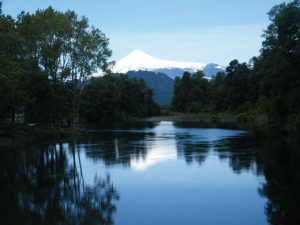
After a quick walk around the town to take some pictures (the ones with sun!), we drove the remaining 250 km or so to our ultimate destination: Puerto Varas. However, once again we decided to start the journey with a scenic detour via Conaripe and Panguipulli. About 40 km of the road was on a dirt road around a lake which we didn’t realise when embarking on it. I don’t like dirt roads much, but this one was suffering just for the views and in truth the road was in very good condition. However, once we were back on the main highway, the stunning scenery was nowhere to be seen. We got to Puerto Varas mid to late afternoon.
As before you can see more photos here and you can read Eneida’s account in Portuguese.Santa Cruz está 30 km a oeste da Ruta 5 (em direção ao Pacífico), em uma estrada de mão única que liga a cidade de San Fernando ao litoral. O nosso hotel estava localizado nesta estrada secundária, a poucos metros da entrada de Santa Cruz. Para voltarmos à Ruta 5 e seguirmos para o sul, resolvemos tomar um caminho diferente por uma estrada vicinal que passa por entre as diversas vinhas da região. Com o auxílio do nosso GPS, a que carinhosamente batizamos de Queenie, chegamos à Teño, de volta à Panamericana que nos levaria à Pucón, 620 km ao sul.
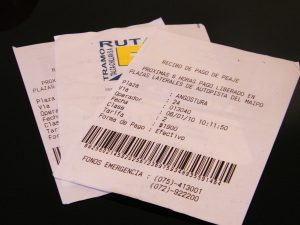
A viagem é bem tranquila, e encontramos a estrada especialmente vazia, devido ao feriado do dia 01/01. Como disse antes, a Ruta 5 é super bem conservada, então dá para justificar os váaarios pedágios que encontramos no percurso. Calculamos que a cada 80-100 km é preciso pagar 1900 pesos chilenos (R$7,00). Fui juntando os comprovantes e, no final da viagem, vi que pagamos mais de 20 pedágios, somando um pouco mais de 40.000 pesos (R$150,00).
Atravessamos o chamado vale central do Chile, a região mais fértil do país, de onde vem grande parte da produção agrícola. Atualmente, a agroindústria toma conta de grande parte da região e, além das vinhas, há plantações de frutas e verduras na maioria do percurso. Durante a viagem até Chillán, especialmente, vê-se enormes galpões de estocagem e processamento de produtos agrícolas. A cordilheira dos Andes, neste trecho, não apresenta montanhas tão altas quanto na região de Santiago ou mais ao norte, mas vez ou outra é possível avistar um pico com neve.
No meio do caminho tinha uma cachoeira…
340 km ao sul de Teño, a poucos metros da Ruta 5, fizemos uma paradinha para conhecer Salto Del Laja, uma cachoeira que, segundo nosso guia de viagem (o livro Rough Guide to Chile, 2006), era uma miniatura de Niagara Falls. Well, me desculpe a cachoeira e o guia, mas tendo estado em Foz do Iguaçu recentemente e conhecendo Niagara Falls, posso dizer que a Salto Del Laja é até bonitinha, mas não é assim nenhuma Niagara. Parece que é um programa popular entre os chilenos, há barraquinhas vendendo souvenirs e estava bem cheio de gente. De qualquer forma, é um lugar para fazer uma paradinha técnica na longa viagem até Pucón.
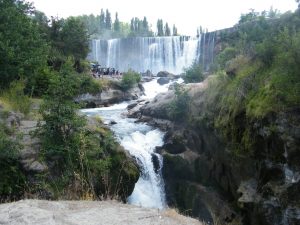
Pucón
Da cachoeira, fomos direto a Pucón, pegando a Ruta 199, já no chamado distrito dos lagos. A partir da cidade de Villarica, são 30 km de estrada margeando o lago Villarica, que oferece aqui e ali belas paisagens. Estávamos apreensivos quanto ao hotel em Pucón. Era feriado, a cidade cheia, e não tínhamos hotel reservado. Resolvemos estacionar na Plaza de Armas e sair procurando. Nossa primeira opção foi o Gran Hotel de Pucón, o hotel mais tradicional da cidade, situado na beira do lago Villarica. Como estava lotado, contornamos a praça e achamos um quarto no Hotel Huincahué, um hotel pequeno e confortável com um quarto bem espaçoso.
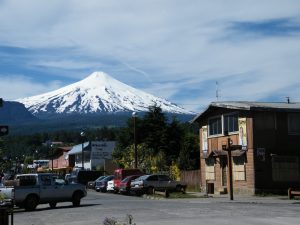
Pucón é uma cidade muito simpática, à sombra do vulcão Villarica, com casas de madeira – um pouco como Gramado. É um destino ideal para os amantes do turismo de aventura, pois de lá é possível: escalar o vulcão Villarica, cavalgar nas encostas do vulcão no Parque Nacional Villarica, fazer rafting nas corredeiras do Rio Huerquehue, pescar nos lagos e rios ao redor da cidade, e muito mais. Nós não fizemos nada disso! Fizemos um passeio até as “praias” do lago Villarica e La Poza, e compramos souvenirs na feira de artesanatos na Plaza de Armas.
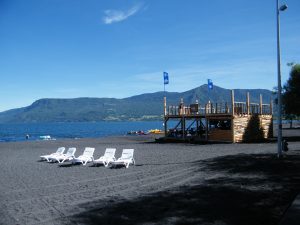
À noite, a cidade é super movimentada, os bares e restaurantes da Av. Bernardo O’Higgins ficam lotados. Ah! e só tem gente bonita, todo mundo magro, de cabelo liso e sorridente. E como são bonitos e simpáticos, os chilenos! Não cruzamos com ninguém mau humorado no nosso caminho. Sempre falam “ya” pra tudo (no castelhano falado por lá “ya” quer dizer sim, ok, tudo bem!).
Os Sete Lagos
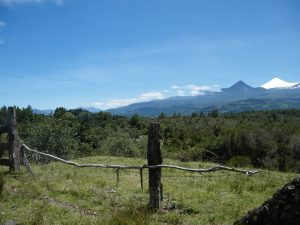
Saindo de Pucón, voltamos em direção à Villarica e de lá, mais uma vez, tomamos uma estrada secundária pela região dos Sete Lagos, que nos levou às paisagens mais bonitas desta parte da viagem. 30 km ao sul de Villarica está o Lago Calafquén e daí rumamos para a esquerda, com direção a Coñaripe. A estrada de terra é bem conservada, nem o Steve reclamou. De Coñaripe, fomos a Panguipulli e de lá voltamos para a Panamericana, na cidade de Los Lagos. O percurso todo, de Pucón à Panamericana, levou umas 2 horas, de lagos e vulcões e rios azuis.
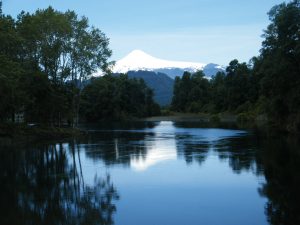
De Los Lagos a Puerto Varas, nossa próxima parada, são 180 km, que foram percorridos em menos de 2 horas. Mas Puerto Varas fica para o próximo post.
Mais da nossa viagem:
Nossa viagem ao Chile (1a parte)
Para ver mais fotos, clique aqui.
Para ler o relato do Steve, escolha a opção “inglês”.
Kristen Hardin says
Hello, I came across your blog and was hoping you could give me more information on your drive from Santa Cruz to Pucon. How many hours did it take? We are planning to do the same thing next week, but now are wondering if we should fly… is is too far to drive? I appreciate your knowledge. Thanks so much.